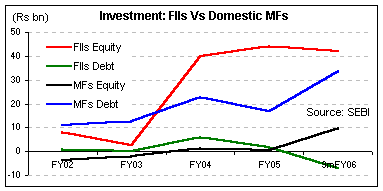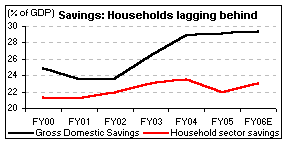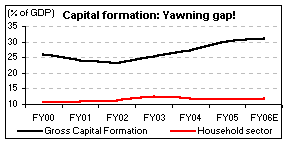India: Adequately invested?
Source: EM
In a recent speech, the new Fed chief, Mr. Ben Bernanke, noted that "consumption alone cannot carry the baggage of acceleration in economic growth, but the same needs to shared by growth in aggregate savings and investment". The world's two major economic super-powers, i.e. the US and China, face divergent issues on these fronts today. While China is facing the issue of excess savings and investment, the US is a victim of saving glut triggered by excessively leveraged consumption.
India, though lagging behind its neighbour (China) in terms gross domestic savings, has shown an appreciable growth in the same (as a % of GDP) over the last couple of years. Infact, most of the government's fiscal incentives have been articulated by way of savings-driven financial planning for Indian residents. Absence of social security plan, unlike the developed nations, and low penetration of pension schemes makes it all the more pertinent for Indian citizens to save adequately.
Taking stock... In its recently released 'Report on Currency and Finance FY06', the RBI took a positive stance on both savings and investment in the economy. This was on the premise that savings as a percentage of GDP has grown from 24% in FY00 to 29% in FY06. The same was attributed to admirable performance of the services sector, lower unemployment levels and higher income growth. Private corporate saving has also been steadily rising since FY03 - thanks to the restructuring exercise over the last seven years. PSUs however, ridden by government intervention in business policies, red tapism and subsidy burden, have grossly under-performed their private sector counterparts and continue to be a 'dis-saver'.
The gross capital formation in India has grown from 26% of GDP in FY00 to 31% of GDP in FY06. This was propelled by investments across infrastructure facilities in the country. Rise in domestic and international tourism aided the growth of hotel industry. Burgeoning revenue earning freight traffic of railways, civil aviation and port traffic propped up the transport sector. Robust growth in the cellular subscriber base and steady growth in broadband connections supported the telecom sector. Renewed offtake of non-food credit marked the consumption growth in retail and upsurge in capex activity across industries.
|
FIIs stealing the cake? While one would like to believe that the Indian citizens have reaped the benefits of a robust stock market in the last three years, the same is not entirely true. While the household sector chose to shy away from active participation in the secondary debt and equity markets, even the domestic institutional investors (mutual funds) have been slow to catch up. Statistics shown by the RBI point out that Indian households have largely restricted themselves to savings in bank and postal instruments, with a minuscule percentage of the population exhibiting an appetite for higher risk instruments like equities. FIIs meanwhile, have had a terrific run and have been the key drivers for the stock market over the last five years.

Retail to pitch in... The upside in savings growth seems sustainable, notwithstanding inflationary pressures in some of the basic goods. But given the FII-driven momentum, the Indian economy remains largely exposed to the perils hot money flowing out. It is here that the retail investors need to pitch in so as to make the Indian equity markets resilient to FII sentiments. A broad based participation of retail investors in equity linked investments will not only enable them reap the fruits of growth of India Inc., but also make them the true beneficiaries of the 'India story'.

